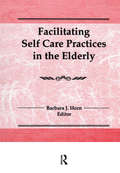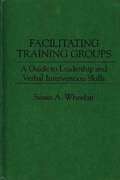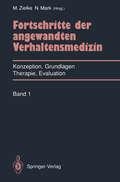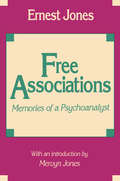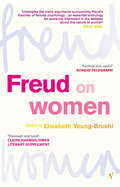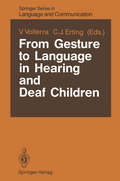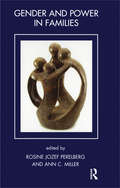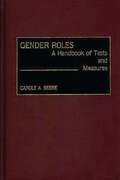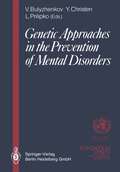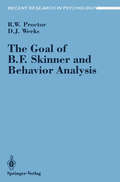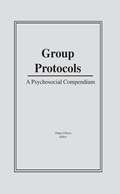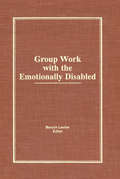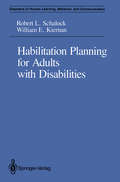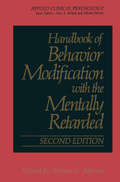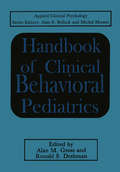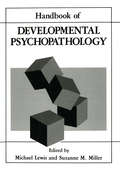- Table View
- List View
Facilitating Self Care Practices in the Elderly
by Barbara J HornThis book is a synthesis of current knowledge from published sources and expert consultants relating to three commonly occurring problems in home health care practice--self-administration of medications, family caregiving issues, and teaching the elderly. For each problem addressed, assessment guides and interventions are outlined, making this book an invaluable resource for professionals, researchers, and agencies concerned with providing top-quality care for the elderly. Home health care agencies can use the guide for orientation of new staff and inservice education for current staff. Home health care staff can use many of the assessment guides and resource lists in their work with clients. Facilitating Self Care Practices in the Elderly can also serve as a basis for standard development. Researchers interested in these clinical problems will find that the literature review and synthesis will facilitate the development of the theoretical underpinning for their research. Educators will find the book helpful in courses and as a basis for curriculum development. First Published in 1990. Routledge is an imprint of Taylor & Francis, an informa company.
Facilitating Self Care Practices in the Elderly
by Barbara J HornThis book is a synthesis of current knowledge from published sources and expert consultants relating to three commonly occurring problems in home health care practice--self-administration of medications, family caregiving issues, and teaching the elderly. For each problem addressed, assessment guides and interventions are outlined, making this book an invaluable resource for professionals, researchers, and agencies concerned with providing top-quality care for the elderly. Home health care agencies can use the guide for orientation of new staff and inservice education for current staff. Home health care staff can use many of the assessment guides and resource lists in their work with clients. Facilitating Self Care Practices in the Elderly can also serve as a basis for standard development. Researchers interested in these clinical problems will find that the literature review and synthesis will facilitate the development of the theoretical underpinning for their research. Educators will find the book helpful in courses and as a basis for curriculum development. First Published in 1990. Routledge is an imprint of Taylor & Francis, an informa company.
Facilitating Training Groups: A Guide to Leadership and Verbal Intervention Skills
by Susan A. WheelanMost trainers rely on trial and error as the only means of improving facilitation skills. This definitive text furnishes a comprehensive framework for determining the best interventions to use in a given group situation. The trainer is presented with strategies for assisting the individual to establish an attainable goal, develop a strategy for change, and implement and evaluate that strategy during and following the life of the group. Both personal and professional development groups are addressed in the model. Most current literature describes how to design management training and human relations group. This text goes a step further by providing a framework for intervening on a moment-by-moment basis to ensure group goal achievement.Facilitating Training Groups provides clear descriptions of three primary models--T-groups, personal growth groups, and skills training groups. Their goals, theoretical underpinnings, and required leadership style are explored. The book focuses on what trainers say and do during the life of a group to facilitate the accomplishment of the goals of a particular model. Trainers learn a process for deciding what interventions to use in different circumstances and models. Practice exercises assist the reader in assimilating the material. This book is particularly relevant for those studying human resources, human resource training, psychology, sociology, and social work.
Familie, Kinderwunsch, Unfruchtbarkeit: Motivationen und Behandlungsverläufe bei künstlicher Befruchtung (Beiträge zur psychologischen Forschung #20)
by Christa BrählerFortschritte der angewandten Verhaltensmedizin: Konzeption, Grundlagen, Therapie, Evaluation
by Manfred Zielke Norbert MarkSport und Ergotherapie. Angstbesetzte kardiovaskuläre Störun gen. Adipositas. Sexuelle Funktionsstörungen. Bulimia nervo- sa. Genußtraining. Ärztliche Gesundheitsberatung. Kosten- Nutzen-Analysen im Gesundheitswesen
Free Associations: Memories of a Psychoanalyst
by Booker T. WashingtonFirst published in 1958, Free Associations is the story of the early life of Ernest Jones. It was prepared for publication by his son Mervyn, who contributed an epilogue covering the period from 1918 (when this book ends) through Jones's death in 1944. This new edition includes a reflective introduction by Mervyn Jones, in which he writes about Ernest Jones "as I could not write in 1958."One of the pioneers in psychoanalysis, Ernest Jones was active in advancing the status as well as the development of the field. In the wider forum of public opinion, he made himself an advocate of the new science-the Huxley, he liked to say, to Freud's Darwin. Huxley had ranked below Darwin in creative originality, and had filled the role of the faithful and indispensably useful follower; and Mervyn Jones believes both Freud and Jones were pleased by the comparison. In addition to his important public and organizational roles (as president of the British and International Psychoanalytic Associations), Jones made significant contributions to psychoanalytic theory. When the Nazis invaded Vienna, he saved much of the assets and archives of psychoanalysis, at great personal risk, and made the arrangements for Freud to come to London.In his introduction, Mervyn Jones presents a sometimes surprising portrait of a thoroughly conventional man in what was then an unconventional profession. He describes tensions and conflicts among the early Freudians, and situates Freudianism with other theories that laid claim to scientific truth in the late nineteenth century.Free Associations presents an evocative picture of Wales and London at the turn of the century, and describes the developing profession of psychoanalysis. It is a dramatic story of success and failure, and of a young man and how he responded to the new, strange ideas of Freud. This book fills in our understanding of the history of psychoanalysis and its founders.
Free Associations: Memories of a Psychoanalyst
by Booker T. WashingtonFirst published in 1958, Free Associations is the story of the early life of Ernest Jones. It was prepared for publication by his son Mervyn, who contributed an epilogue covering the period from 1918 (when this book ends) through Jones's death in 1944. This new edition includes a reflective introduction by Mervyn Jones, in which he writes about Ernest Jones "as I could not write in 1958."One of the pioneers in psychoanalysis, Ernest Jones was active in advancing the status as well as the development of the field. In the wider forum of public opinion, he made himself an advocate of the new science-the Huxley, he liked to say, to Freud's Darwin. Huxley had ranked below Darwin in creative originality, and had filled the role of the faithful and indispensably useful follower; and Mervyn Jones believes both Freud and Jones were pleased by the comparison. In addition to his important public and organizational roles (as president of the British and International Psychoanalytic Associations), Jones made significant contributions to psychoanalytic theory. When the Nazis invaded Vienna, he saved much of the assets and archives of psychoanalysis, at great personal risk, and made the arrangements for Freud to come to London.In his introduction, Mervyn Jones presents a sometimes surprising portrait of a thoroughly conventional man in what was then an unconventional profession. He describes tensions and conflicts among the early Freudians, and situates Freudianism with other theories that laid claim to scientific truth in the late nineteenth century.Free Associations presents an evocative picture of Wales and London at the turn of the century, and describes the developing profession of psychoanalysis. It is a dramatic story of success and failure, and of a young man and how he responded to the new, strange ideas of Freud. This book fills in our understanding of the history of psychoanalysis and its founders.
Freud on Women
by Elisabeth Young-BruehlFREUD ON GIRLS: 'They go through an early age in which they envy their brothers their signs of masculinity and feel at a disadvantage and humiliated because of the lack of it...' FREUD ON WOMEN: 'At one time (in a matriarchal society) the woman may have bee the dominant partner. In this way, like the defeated deities, she acquired demonic properties...'AND ON HIMSELF: 'My mother was nowhere to be found; I was crying in despair. My brother Philip...unlocked a wardrobe for me, and when I did not find my mother within it either, I cried even more until, slender and beautiful, she came through the door. What can this mean?'This collection contains Freud's most significant statements on women, taken form letters as well as published work, presenting a clear, accessible view of the progress of his thought and his own struggle for understanding and coherence. Elisabeth Young-Bruehl untangles the arguments, relating Freud's ideas on women and on bisexuality to his clinical practice and broader theory, while the annotated bibliography traces the later disputes.
From Gesture to Language in Hearing and Deaf Children (Springer Series in Language and Communication #27)
by Carol J. Erting VirginiaVolterraVirginia Volterra and Carol Erting have made an important contribu tion to knowledge with this selection of studies on language acquisi tion. Collections of studies clustered more or less closely around a topic are plentiful, but this one is 1 nique. Volterra and Erting had a clear plan in mind when making their selection. Taken together, the studies make the case that language is inseparable from human inter action and communication and, especially in infancy, as much a matter of gestural as of vocal behavior. The editors have arranged the papers in five coherent sections and written an introduction to each section in addition to the expected general introduction and conclu sion. No introductory course in child and language development will be complete without this book. Presenting successively studies of hearing children acquiring speech languages, of deaf children acquiring sign languages, of hear ing children of deaf parents, of deaf children of hearing parents, and of hearing children compared with deaf children, Volterra and Erting give one a wider than usual view oflanguage acquisition. It is a view that would have been impossible not many years ago - when the primary languages of deaf adults had received neither recognition nor respect.
Gender and Power in Families
by Ann C. Miller Rosine Jozef PerelbergThe systems approach to the family is based on the assumptions that there is equality between men and women in the family, and that women and men are treated equally in clinical practice. The contributors to this book challenge these hidden assumptions, discussing the issues from both a conceptual and clinical viewpoint. They argue strongly that questions of gender and power should be central to family therapy training and practice.
Gender and Power in Families
by Ann C. Miller Rosine Jozef PerelbergThe systems approach to the family is based on the assumptions that there is equality between men and women in the family, and that women and men are treated equally in clinical practice. The contributors to this book challenge these hidden assumptions, discussing the issues from both a conceptual and clinical viewpoint. They argue strongly that questions of gender and power should be central to family therapy training and practice.
Gender Roles: A Handbook of Tests and Measures
by Carole A. BeereBeere has produced a new edition of her Women and Women's Issues: A Handbook of Tests and Measurements. Based largely on a search of the PsychLIT and ERIC databases from January 1978 to December 1988, the volume includes information on 211 tests and measures pertaining to gender roles and attitudes towards gender. . . . Particularly useful are chapter reviews of the literature in which the author reviews the quality of available research. Recommended for college and university libraries. ChoiceThis handbook stems, in part, from the author's previously published Women and Women's Issues. Realizing that a book published in 1979 could no longer provide researchers with the up-to-date information they require regarding measures to use in research, Beere set out to revise and update her work. In the process, she soon discovered that the measures identified through her search of the literature produced since her first book was published far exceeds the number that can be realistically described in a single handbook. Thus, she has undertaken a two-volume guide, the first of which, Gender Roles, describes only those measures pertaining to gender roles and attitudes toward gender-related issues. Gender roles are broadly defined to include adults' and children's gender roles, gender stereotypes, marital roles, parental roles, employee roles, and multiple roles. A total of 211 measures are included.In addition to 67 scales still in use that were described in her earlier book, Beere includes scales that are relevant, have evidence of their reliability and/or validity, and are used in more than one published article or ERIC document. If a scale does not satisfy these criteria, but its development is the focus of an article or ERIC document, it is included, as are scales that are unusual or pertain to a topic that would otherwise receive inadequate coverage in this handbook. The scale descriptions follow a standard format that includes the following information: title; author or authors as listed in the earliest publication mentioning the scale; earliest date that the scale is mentioned in a publication; profile of variable being measured; type of instrument; description; sample items; previous and appropriate subjects; scoring information; a description of the development of the measure; information regarding reliability and validity; and a listing of published studies that use the measure. This important new handbook promises to make several important contributions to gender-related research. It will make it easier for researchers to locate quality instruments appropriate for their research, discourage the proliferation of substandard or redundant measures, set some minimal standards for measures used in gender role research, and encourage more research regarding gender roles. All social science libraries will want to find a place for it in their reference collections.
Genetic Approaches in the Prevention of Mental Disorders: Proceedings of the joint-meeting organized by the World Health Organization and the Fondation Ipsen in Paris, May 29–30, 1989
by Victor Bulyzhenkov, Yves Christen and Leonid PrilipkoAt least 40 million people in the worId suffer from the most severe forms of mental disorder such as schizophrenia and some 300 million more are affected by less severe but still incapacitating forms of these conditions, including, for example, drug and alcohol dependence and the consequences of brain trauma. The enor mous magnitude of human suffering and the economic losses usually linked of these disorders make them a problem of major public health importance. Recent years have brought with them scientific discoveries which have made it possible to successfully treat most mental disorders and to prevent many others. Some of them, however, cannot be prevented on the basis of today's knowledge, and their treatment remains palliative: further progress in their management awaits an improvement in our understanding of mechanisms by which they come into existence and of factors which influence their course. Recent years have also seen a significant increase in knowledge about genetic factors influencing the occurrence and course of a variety of diseases, for example, cystic fibrosis, Duchenne type muscular dystrophy, thalassemia, and hyperten sion. Some of this knowledge and some of the methods that have been developed to obtain it could have direct relevance to the search for a c1earer comprehension of the pathogenesis of mental disorder.
The Goal of B. F. Skinner and Behavior Analysis (Recent Research in Psychology)
by Robert W. Proctor Daniel J. WeeksIn this new volume in Springer-Verlag's series "Recent Research in Psychology", Drs. Proctor and Weeks examine what has long been a "self-asserted superiority" of behavior analysts and Skinnerian researchers. Most behavior-analytic views derive from the philosophy of radical behaviorism, as conceived by B.F. Skinner, and prescribe a "world view" where environmental contingencies determine all aspects of behavior. This view necessarily assumes all other views to be inferior because of its world view, hence, those subscribing to behavior analysis will tolerate no other theory. The Goal of B.F. Skinner and Behavior Analysis examines closely the rationale behind the Skinnerian philosophy, challenging its validity through the author's own research.
Group Beliefs: A Conception for Analyzing Group Structure, Processes, and Behavior (Springer Series in Social Psychology)
by Daniel Bar-Tal"Individuals who live in groups hold common beliefs which define their reality, not only as persons, but also as group members. This reality becomes especially important when group members become aware that they share beliefs and are convinced that these beliefs characterize them as a group. In this case common beliefs become group beliefs." With this statement, Dr. Bar-Tal begins his far-reaching analysis of beliefs as a group phenomenon. Group beliefs are shown to have important behavioral, cognitive, and affective implications for group members and the group as a whole. They may contribute to the behavioral direction a group takes, coordinate group activities, determine the intensity and involvement of group members, and influence the way group members affect the leaders. This book introduces and articulates the implications of a new concept of group beliefs, shedding new light on the structure and processes of groups, focusing on such phenomena as group formation, subgrouping, splits, mergence and group disintegration. By taking an interdisciplinary approach, this integrative conception opens new avenues to the study and understanding of group behavior.
Group Protocols: A Psychosocial Compendium
by Diane GibsonHere is a valuable book intended to help those occupational therapists working in mental health settings to refine their critical thinking about the group activities they select and the protocols they design. Experts focus on practicing sound clinical reasoning and clinical decision making to ensure careful assessment of which activities, structured in what fashion, are appropriate for particular populations. They also address the topic of providing services that are relevant, practical, have already delineated goals and objectives, produce outcome data, and can be replicated across settings. Group Protocols: A Psychosocial Compendium offers readers a systematic approach to the assessment and design of group protocols, plus a wide variety of sample protocols from which treatment strategies may be drawn. Because this volume represents a style of thinking rather than a singular theoretical frame of reference, it will be useful to any occupational therapist for whom groups are an essential aspect of professional practice.
Group Protocols: A Psychosocial Compendium
by Diane GibsonHere is a valuable book intended to help those occupational therapists working in mental health settings to refine their critical thinking about the group activities they select and the protocols they design. Experts focus on practicing sound clinical reasoning and clinical decision making to ensure careful assessment of which activities, structured in what fashion, are appropriate for particular populations. They also address the topic of providing services that are relevant, practical, have already delineated goals and objectives, produce outcome data, and can be replicated across settings. Group Protocols: A Psychosocial Compendium offers readers a systematic approach to the assessment and design of group protocols, plus a wide variety of sample protocols from which treatment strategies may be drawn. Because this volume represents a style of thinking rather than a singular theoretical frame of reference, it will be useful to any occupational therapist for whom groups are an essential aspect of professional practice.
Group Work With the Emotionally Disabled
by Baruch LevineHere is an exciting and informative volume on the use of social group work in psychiatric settings. As it affirms the significance of social group work’s clinical potential, Group Work With the Emotionally Disabled fosters further development in this highly specialized area of human service.Baruch Levine, a prestigious social group worker and clinical theorist, has edited this exceptional volume that emphasizes the coexistence of mental illness and mental health in effective group experiences for treating mental disability. Readers are treated to a comprehensive history of the development of the use of social group work practice with the emotionally disabled in psychiatric settings. Other authoritative chapters focus on the practice aspect and explore the problems and issues in group work with the emotionally disabled, the settings for group treatment of the chronically ill and psychiatrically at-risk, and the development of comprehensive approaches to the treatment and rehabilitation of persons with severe mental illness.
Group Work With the Emotionally Disabled
by Baruch LevineHere is an exciting and informative volume on the use of social group work in psychiatric settings. As it affirms the significance of social group work’s clinical potential, Group Work With the Emotionally Disabled fosters further development in this highly specialized area of human service.Baruch Levine, a prestigious social group worker and clinical theorist, has edited this exceptional volume that emphasizes the coexistence of mental illness and mental health in effective group experiences for treating mental disability. Readers are treated to a comprehensive history of the development of the use of social group work practice with the emotionally disabled in psychiatric settings. Other authoritative chapters focus on the practice aspect and explore the problems and issues in group work with the emotionally disabled, the settings for group treatment of the chronically ill and psychiatrically at-risk, and the development of comprehensive approaches to the treatment and rehabilitation of persons with severe mental illness.
Habilitation Planning for Adults with Disabilities (Disorders of Human Learning, Behavior, and Communication)
by Robert L. Schalock William E. KiernanHabilitation Planning for Adults With Disabilities presents a comprehensive approach to habilitation planning and service delivery for adults with disabilities. This book investigates the increased demands and expectations by adults with disabilities regarding personalized service and quality of life, including independence, productivity, and community integration, and discusses historical and current treatment and trends. This book is presented in five main sections: definitions and background material; lifestyles and living, work, and recreational environments; habilitation strategies; personal growth and quality of life for the affected adult; and the present and future trends in habilitation planning. Rehabilitation personnel in the areas of administration, assessment/training, case management, or evolution; applied psychologists; and professionals and students in special education, rehabilitation counseling, human service or health adminstration will be interested in this volume.
The Hamilton Scales (Psychopharmacology Series #9)
by AlecCoppen PerBechThe European College of Neuropsychopharmacology (ECNP) is a scientific and educational association which represents a variety of disciplines. The first ECNP congress took place in Copenhagen, May 1985, where a working group of European scientists within the field of psychopharmacology was elected to prepare a constituent ECNP congress in Brussels, 1987. Among the most active members of this group was Max Hamilton. At the second ECNP congress in Brussels Max Hamilton was elected as the first honorary member of the ECNP. When we received the message of his death we decided at once to arrange a Max Hamilton memorial symposium at the third ECNP congress, May 1989, in Gothenburg, Sweden. This monograph contains the proceedings of the Max Hamilton symposium which was chaired by the editors. The opening lecture of the third ECNP congress was a Max Hamilton lecture: "A life devoted to science in psychiatry" which was presented by Sir Martin Roth. It seemed obvious to include Sir Martin's lecture as the opening article of this monograph. Although G .E. Berrios was unable to participate in the ECNP congress we have found it logical to include his manuscript on "The Hamilton Depression Scale and the Numerical Description of the Symptoms of Depression" as another personal contribution to Max Hamilton and his rating scales.
Handbook of Behavior Modification with the Mentally Retarded (Nato Science Series B:)
by Johnny L. MatsonThe development of behavior modification principles and procedures and the ensuing research have had a dramatic impact on services for mentally re tarded persons. This book is the second edition of a volume that is designed to update readers on some of these many developments. Although many of the chapter titles and authors from the first edition remain unchanged, we have added additional chapters to reflect new areas of research. The book is thus a critical review of this literature and, as such, provides essential and important notions about what we know and what can be done to expand our current knowledge. The authors of the chapters are all recognized experts who have been active in publishing in the research areas they critique. As a result, they have a good understanding of what are the major issues in the field. And because they are also active in service provision to persons with identified handicaps, their material will be especially useful to practitioners and, it is hoped, to those_ professionals who are working in the field in estab lishing data-based treatments. One important change in the field has concerned the terminology used to We are aware that persons with mental retar describe handicapped persons. dation are no longer referred to as "the mentally retarded," and although no disrespect is intended, for the sake of continuity the original title has been retained on the advice of the publisher.
Handbook of Clinical Behavioral Pediatrics (Nato Science Series B:)
by Alan M. Gross Ronald S. DrabmanSince 1978, the editors have collaborated on several research projects and spent many hours at conventions discussing research, graduate education, and patient care. The idea for this volume arose when we both concluded that the area of behavioral pediatrics needed a "how to" book. Several important scholarly re views had recently appeared. They presented excellent summary information concerning the general assumptions and theories underlying the area of behav ioral medicine with children. But these volumes devote very little attention to the application of clinical methods. What was needed, we thought, was a book that would allow graduate students and practicing clinicians the opportunity to peer into the minds of eminent practitioners and understand their thinking. Thus the book was conceived. Editing books represents a special kind of challenge. One has to "sell" an idea to a group of distinguished colleagues. They have to believe enough in that idea to devote the considerable time and effort necessary to bring thought into reality. In this case, there were two ideas we tried to sell to our colleagues.
Handbook of Developmental Psychopathology
by Suzanne M. Miller MichaelLewisDevelopmental psychopathology is the new child on the block. As yet not an overly sturdy child, but one clearly out of the cradle, an active toddler and an enterprising explorer of the boundaries of its province. It wasn't always so. Only 15 years ago Thomas Achenbach in publishing the first edition of his book used a recently coined title, Developmental Psychopathology, and began the volume with a provoking first sentence: "This is a book about a field that hardly exists yet. " Seven years later when the second edition appeared, that sentence had been deleted. In place of the original 13-page chapter, on the "Developmental Approach to Psychopathology in Chil dren," there was a 40-page chapter focused on the biological, cognitive, social-emotional, and educational perspectives in development, together with a lengthy account of develop mental periods and an integrative statement on the constituents of a developmental framework. Other signs and symptoms began to appear. Child Development, a doyen for develop mentalists, devoted a special issue, under the guest editorship of Dante Cicchetti, to an emergent developmental psychopathology. This year saw the publication of a new journal, Development and Psychopathology (1989), edited by Cicchetti and Nurcombe. And attend ees at recent meetings of the Society for Research in Child Development can attest to the growing interest of the membership in the linkage of development and psychopathology as seen and heard via posters, symposia, and guest speakers.
